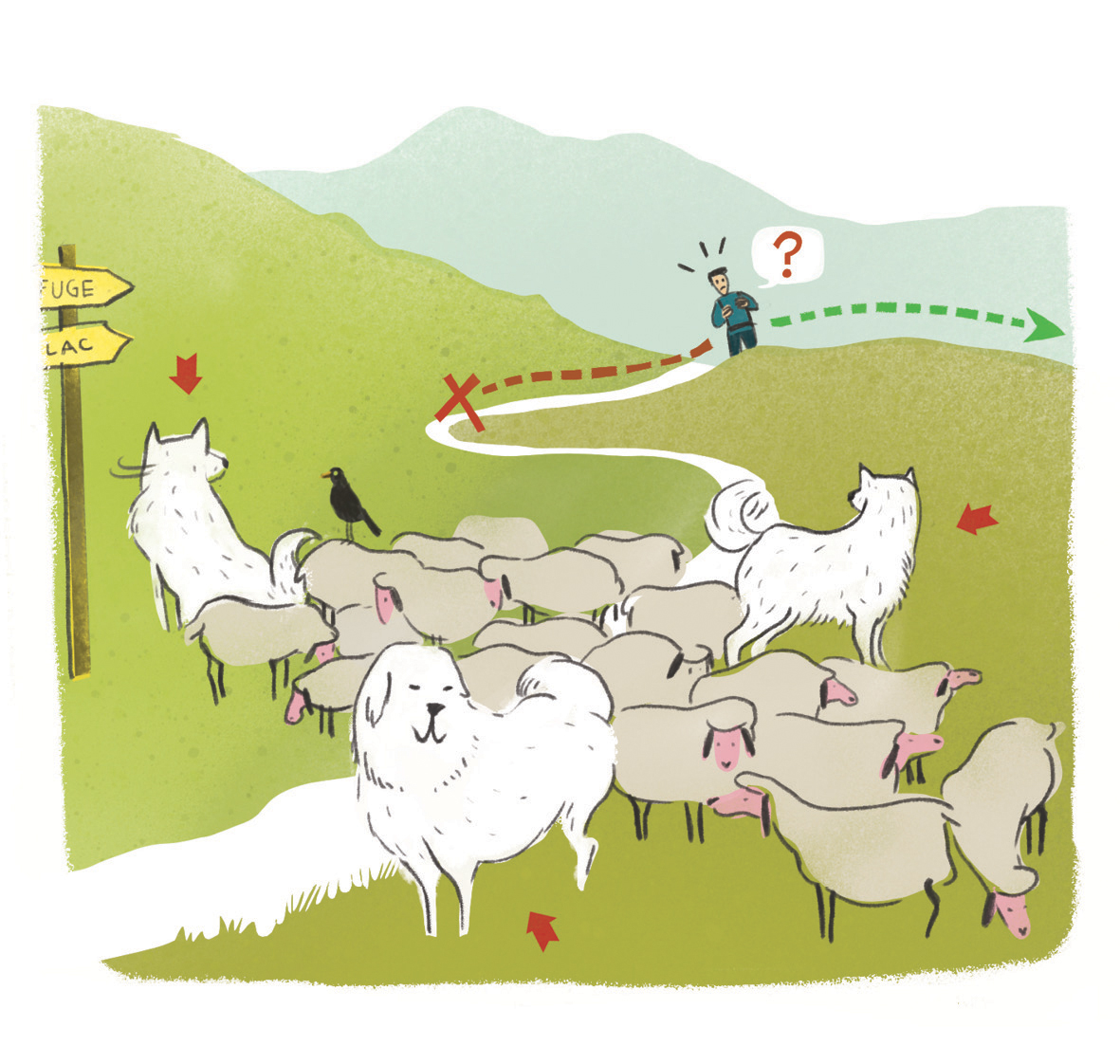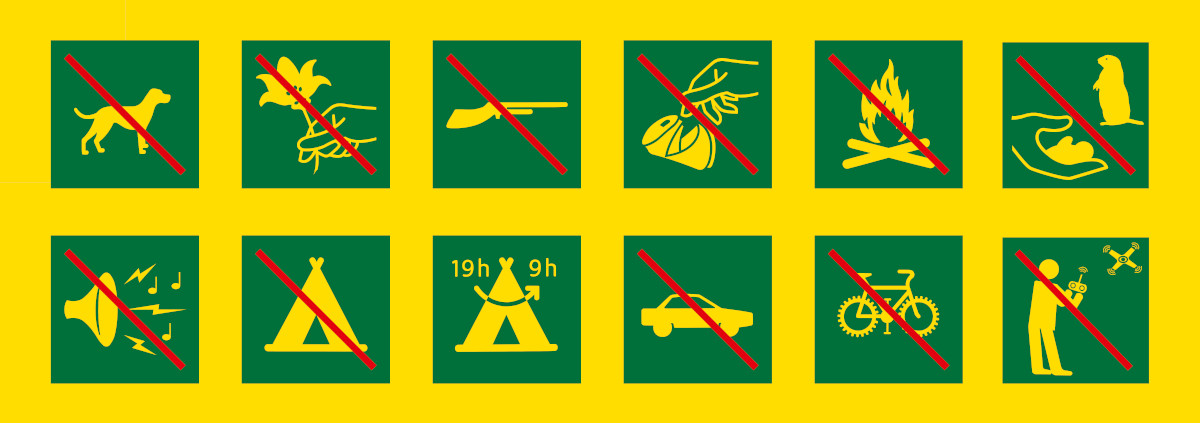Col des Terres Blanches from Prapic
Magic and enchantment in a lunar landscape "Oh! What dirty pigs!" They have left their empty bottle in this supernatural setting! I get closer to pick it up, but a few metres away I realise my mistake. It is not a bottle but a mountain hare! It relies on its motionlessness to blend into the background. I saw you! Fold your ears back next time!"
Michel Francou, warden in the Champsaur area
19 points of interest
 History
HistoryPrapic Church
Dedicated to Saint-Anne, Prapic Church dates back to the 1860s. It was built following the request of the inhabitants for a place of worship, who were faced with the hazards of winter and the distance from the parish church in Orcières. On the stained glass choir window, you can admire the portrait of Prapicois: Jean Sarrazin (1833-1914), nicknamed the «the poet of the olives", a different poet from that in the tomb ... Can you find it?
 Architecture
ArchitecturePrapic Hamlet
Surrounded by vegetable gardens, piles of stones and mown terraces the village nestles on the banks of the Drac and gives the best land over to agriculture. The typical house is most often perpendicular to the slope, based on an architecture created from materials collected locally and showing great intelligence in its elaboration. From course plasterwork to the delicacy of walnut wooden doors, shale roofing with gables made from plaited alder, this is the architectural vocabulary that punctuates your visit.
 History
HistoryRunning water
Running water came to Prapic in 1924. The first pipes were made from metre long sections, hollowed out trunks of larch. Their fitments probably did not enable all the water collected from the six village fountains to be transported!
 Water
WaterThe Drac Noir
This denomination is due to the nature of the terrains that it crosses: the limestone is very sensitive to erosion and the metamorphic rocks in Champoléon valley (Drac Blanc) darken the waters of the river Drac in this way. Bouncing from waterfalls to pools, opening up a passage through the riverside alders, the Drac expresses its nature as a mountain torrent. Brown Trout, White Throated Dipper and delicate ephemerals reveal themselves to the attentive observer.
 Fauna
FaunaMarmot
If you are patient, you will probably be lucky enough to discover it on the Charnière plateau whose prairies it particularly appreciates, which sometimes poses a problem to the farmer mowing there. Even so, they do represent an undeniable attraction in the valley. Do not be fooled by their easy going appearance, they are wild animals who fight for survival and battles between males can be fierce.
 Flora
FloraHay Fields
These natural prairies have never been cultivated. You can find a cavalcade of flowers growing freely. From this botanical diversity flourishes a multitude of insect species especially butterflies, who find an environment favourable to their development. Also, the hay they produce has a very high nutritional value. Maintaining the equilibrium of these environments is essential.
 Flora
FloraAsphodel
Asphodels blossom on the old hayfields. They open out from the bottom to the top over the course of July. It is for this reason that flowers at the base of the flowering stem may go to seed while the flowers at the top are still in bud. The long narrow leaves that grow up from the bottom of the stem early in the spring have given it the nickname "Dogs' leek". Vernacular heritage
Vernacular heritageSmall stone walls and stone piles
Creating land from the mountain rocks, this is the combat that the mountain-dwellers have carried out since Antiquity. These piles of stones are the witnesses to the time when numerous children piled up stones so that their families could grow food on the conquered land. The family plot, bordered by walls, was ready to be mowed. The Park participes in the maintenance of this inheritance.
 Architecture
ArchitectureSaulce Chapel
You will be able to see it from the first bends up to the Charnières plateau. It is characterized by its apse forming a stem post whose bulk protects the unique roomed vaulted edifice from avalanches. Built from stones from the site, its lime mortar is filled with earthy grit taken from the immediate environment.. It resists the ravages of time and natural phenomena.
 Geology and geography
Geology and geographyGlacial Relief
The polished rocks that you find just after the walkway are traces of the passage of quaternary glaciers. These are striped; stones once set in the ice, carried by glacial movement have strongly marked them. The flat bottomed valley with a glacial cross cliff is another characteristic of this landscape modelled by glaciers.
 Pastoralism
PastoralismPastoral Cabin at Saut du Laire
Protected from avalanches by a big rock, this small cabin shelters the shepherd from June to the end of July. In order to exploit the supply of grass as it grows, another cabin is situated above the bar which closes the valley completing the equipment of the pasture. For the tranquility of the shepherd, it is best to observe the cabin from a distance.
 Pastoralism
PastoralismPastoralism on the Barre plateau
The National Park has an agreement with sheep breeders concerning the management of pastures in ways that respects the wild fauna, and are likely to improve the quality of the pastures. The Barre plateau is where the flock from Saut du Laire spend August. Barre of hut (cabane)? Which gave its name to the other? The hut to the barre? Or the barre to the hut? Flora
FloraAndrosace vitaliana
A bright patch that blossoms at the same time as snowmelt, Androsace vitaliana is a primulaceae (in other words part of the primrose family). This spring plant, brightens up the recently snow-cleared rockeries with is sulphur-yellow jewels. Strongly rooted in the bare soil, its more or less dense leaf base is made up of stacked up rosettes. Pass
PassTourettes mountain pass
The well-named Tourettes pass, is the way to get to Chateau-Roux, in the Durance valley. Up until the nineteen sixties, it was a route used by flocks of sheep who were heading to the Guillestre fair. Geology and geography
Geology and geographyCasse Blanche
Casse Blanche is scree made up of dolomite. This rock gets its name from the geologist Dolomieu who was the person who described it at the beginning of the 18th century. A surprising phenomenon is associated with it: from afar, the rock seems to be very pale, but a fragment of it in your hand reveals a darker shade... Know-how
Know-howSignposting and maintenance of the footpaths
For over twenty years, the Ecrins National Park has developed clear signposting that helps you along the trails. Equally, the upkeep of the tracks is a continual concern, but it must be said that nothing is permanent in the mountains. As you walk across at an altitude of 2500 m, your legs are tired. Imagine what it would be like if you had to carry a pickaxe as well, in order to maintain the trail. Flora
FloraAltitude flora
Eight-petal mountain avens, moss campion, alpine toadflax, saussurea or berardia are all flowers that have adapted to the extreme conditions and have less competition from other species here. Fauna
FaunaMountain hare
"Lepus Timidus" the latin name for the mountain hare, says it all! He certainly is timid! You are more likely to spot it by chance than because you were looking for it. In winter, it is white, which is its way of coping with its predators which are foxes and golden eagles. Geology and geography
Geology and geographyTerres Blanches pass
Below the path, the sight of the rock that has been eroded by water is fascinating. The Terres Blanches pass is a ball of gypsum. Settled at the edge of the alpine ocean 230 million years ago, this rock was then catapulted to an altitude of 2700m some thirty million years ago, because of shifting of tectonic plates. Gypsum is a highly soluble and brittle rock, and nature is left to do what it will to surprise us.
Description
From the Prapic car park head up towards the hostels. At the fork in the road (sign) go right. The track runs up along the right bank of the Drac to reach the Charnières plateau. At the oratory, go left to cross the plateau. Walk up the bends that lead to the Saulce chapel. Stay on the right bank until you reach the Saut du Laire footbridge that leads to the valley of the same name. From there, cross the first bridge of the gorges, then the second one 100 m upstream. The path continues to the right towards the Barre de la Cabane. Then the valley skirts up to the left avoiding the Barre de la Cabane. The Barre mountain hut is visible from the bottom of the pasture, leave it on the left hand side and continue until you reach an intermediary plateau. The path continues its way through the pastures until it splits in two: do not follow the right-hand route but follow a long pathway across the slope. Cross the stream and continue to climb until you reach the pass and keep your eyes peeled! No, this a not a hallucination due to lack of oxygen, welcome to the Terres Blanches pass. The return trip is made using the same itinerary in the opposite direction.
- Departure : Prapic
- Towns crossed : Orcières and Freissinières
Forecast
Altimetric profile
Sensitive areas
Golden eagle
- Impacted practices:
- Aerial, , Vertical
- Sensitivity periods:
- JanFebMarAprMayJunJulAug
- Contact:
- Parc National des Écrins
Julien Charron
julien.charron@ecrins-parcnational.fr
Recommandations
Flocks of sheep may be guarded by dogs. Some may be good-natured but others less so. Keep calm and keep your distance.
 In mountain pastures, protection dogs are there to protect the herds from predators (wolves, etc.).
In mountain pastures, protection dogs are there to protect the herds from predators (wolves, etc.).
When I hike I adapt my behavior by going around the herd and pausing for the dog to identify me.
Find out more about the actions to adopt with the article "Protection dogs: a context and actions to adopt".
Tell us about your meeting by answering this survey.
Information desks
House of Champsaur
, 05260 Pont-du-Fossé
Information and documentation, temporary exhibitions. Sale of products and works of the Park. In the same space, home office Tourist High Champsaur. Free admission. All animations of the Park are free unless otherwise stated.
Information centre of Prapic (summer only)
, 05170 Prapic
Information centre of the National Park and the Tourism Office of Orcières. Information, documentation. Sale of products and works of the Park. Free admission. All animations of the Park are free unless otherwise stated.
Transport
Consider car sharing.
Access and parking
From the village of Orcières, drive 4.5 km on the CD474 towards Prapic.
Parking :
Source

Report a problem or an error
If you have found an error on this page or if you have noticed any problems during your hike, please report them to us here:



